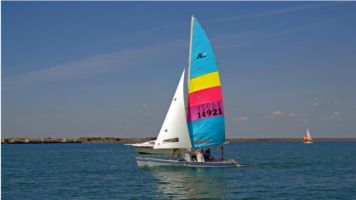The metal hardware on the H18 is aluminum (cast or extruded) and stainless steel.
I did a similar repair to what you describe by adding a riveted reinforcement plate to the front crossbar. I actually put the plate on the inside of the crossbar so there was no issue with getting the mast step to seat properly. The plate was cut from a scrap piece of Hobie 14 mast, and the curve matched the curve of the 18 crossbar almost perfectly. In that case, the crossbar I was repairing had a hairline crack starting between the holes for the mast step so I wanted to reinforce it. If your crossbar isn’t cracked, I would probably skip the plate and just re-rivet the step back down, using 1/4 diameter rivets if necessary. Anyway, if you do plate it, put the plate inside and you will save yourself some hassles with fitment issues. I would also skip the bottom plate- probably overkill.
Here is a post I made a while back about mast step replacement you may also find useful.
https://www.hobie.com/forums/viewtopic.php?f=13&t=42441&p=175874&hilit=Crossbar#p175874sm






